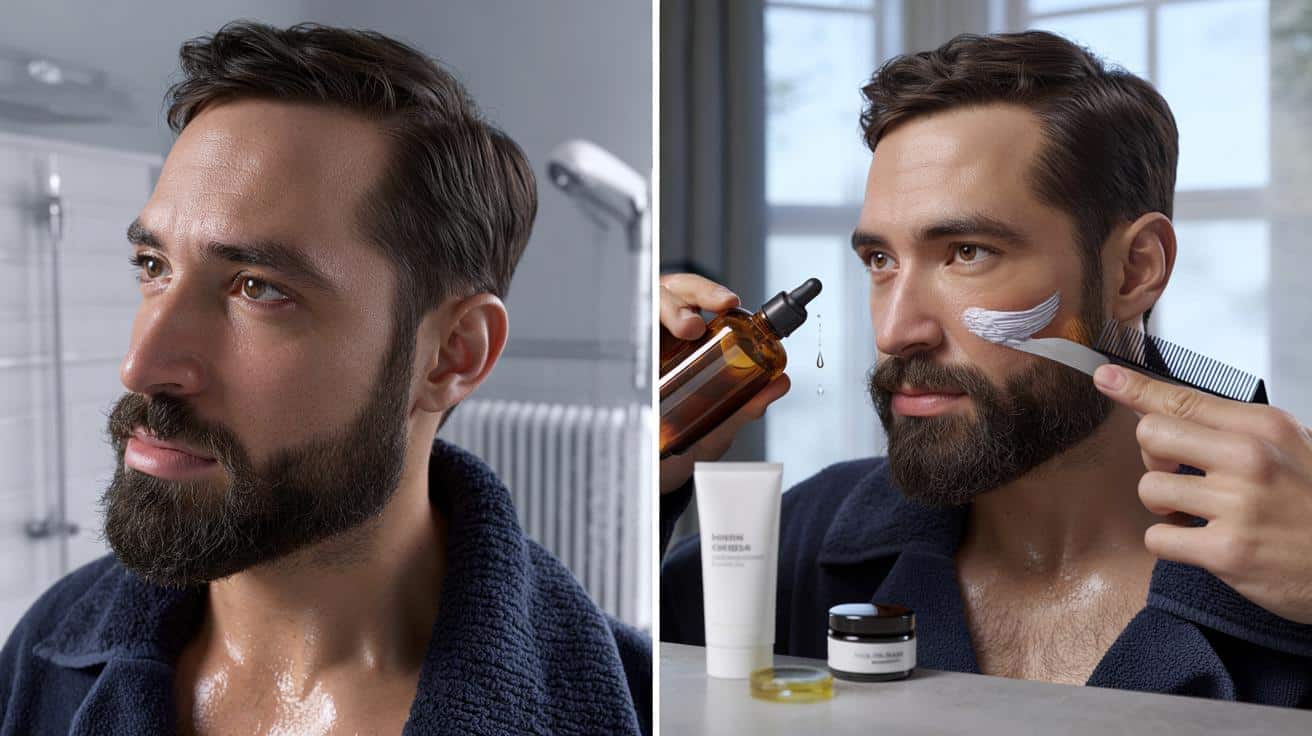The fallout shows on jumpers and meetings.
The problem sits under the hair, not in it. Skin dehydrates, then the beard rubs that fragile surface raw. We put simple swaps to work and tracked which ones actually quieten itch without leaving your chin greasy.
Why dry skin under your beard bites harder
Facial hair changes how moisture moves. It wicks water off the surface, then slows natural oils from spreading where they should. So the skin dries while the hair drags across it. The itch often peaks two hours after a shower, not during it, because hot water spikes water loss and leaves microscopic cracks as it evaporates. Radiators and office air con squeeze out what’s left. Dark knitwear simply reveals the damage.
Shampoo on beards makes matters worse. Hair shampoo targets scalp oil and styling build-up. Those cleansers are stronger than most faces tolerate. Daily use strips the barrier, so you reach for thicker balms, which then sit on dry skin and feel great for ten minutes. The itch returns by elevenses.
Fix the barrier first. Style the beard after. Change the order and the results change with it.
What real-world tests are showing
We ran a low-key trial with volunteers in barber chairs and home bathrooms. The swap was simple: no hair shampoo on the beard for two weeks; use a mild, pH-balanced face cleanser and lukewarm rinses. Cyclists who arrived with windburn and flakes along the jawline saw less sting by day five. Chefs working in hot, dry kitchens cut visible “beardruff” by reducing wash days and applying moisturiser under the hair. The theme repeated across jobs and routines: calmer skin made the hair behave.
Barbers backed it. They see the same pattern hourly. Heavy fragrance, high heat and harsh surfactants push clients into a loop of scratching, over-washing and over-scenting. A quieter routine breaks the loop.
The three-layer hydration method
Do this within 60 seconds of towelling so the skin stays slightly damp:
- Rinse the beard with lukewarm water. Pat until just damp, not dripping.
- Smooth a pea of humectant on the skin under the beard. Aloe or low-weight hyaluronic works well.
- Apply a fragrance-free moisturiser to the same skin. Ceramides or 2–5% urea help bind water.
- Finish with 3–5 drops of jojoba or squalane through the beard. Work from cheeks to chin, then neckline.
- Comb once to distribute. If you blow-dry, keep it cool and hold the nozzle 20 cm away.
Oil goes over moisturiser. That seal slows evaporation and keeps the calm for hours, not minutes.
Common traps that keep skin angry
- Daily shampooing, especially with menthol or citrus oils that can sting sensitised skin.
- Hot showers that spike trans-epidermal water loss and leave tight, shiny skin.
- High heat from dryers that roughens hair cuticles and scratches the surface.
- Gritty scrubs under hair that create tiny tears and flare redness.
- Balms pressed into the skin rather than smoothed over the outer beard.
- Fragrance overload from oils, balms and washes stacking on each other.
- Wool collars and harsh laundry detergents that rub the neckline raw.
Swap heat, harshness and heavy scent for lukewarm water, pH ~5.5 cleanser and unscented formulas. Your barrier notices fast.
What changes when you stick to it
Week one tends to bring small but clear wins. The afternoon sting fades. You find fewer micro-scratches at the neckline. Hairs bend more and snag less on collars. By week two, flakes shrink and shed less. Oils stop vanishing in an hour because they sit on hydrated skin, not a parched canvas. The beard lies flatter, so the overall shape looks sharper without extra product.
Not seeing a shift by day 14? Audit triggers. Long, steamy showers. Aftershaves on broken skin. High-fragrance oils. Rough scarves. Even hard water can sabotage the routine. If you notice oozing, intense soreness or thick, yellowish scale, speak to a GP or a dermatologist; beard flaking often overlaps with seborrhoeic dermatitis and needs targeted care.
| Change | When you notice it | What to do next |
|---|---|---|
| Itch intensity drops | Days 4–7 | Keep rinses lukewarm; avoid fragrance; maintain the three layers |
| Flakes get smaller | Days 7–10 | Add a weekly PHA or lactic acid on clean, dry skin before moisturiser |
| Beard looks neater | Days 10–14 | Trim split ends; use a soft balm on lengths, not on the neck |
| No improvement | By day 14 | Patch-test products; review water temperature; consider a GP check for seborrhoeic dermatitis |
Tools, tweaks and small rituals that add up
Make water an ally. Rinse after workouts or commutes. Pat, don’t rub. Work moisturiser onto damp skin beneath the beard. Then add oil to the hair itself, not the neck. This keeps the skin plump without leaving a waxy line under your jaw. If you like control, melt a speck of balm between palms and glide it over the outer beard only.
Keep heat low. Use a wide-tooth comb first to part the hair so product can reach the skin. Follow with a soft boar bristle brush once mostly dry to distribute oil. Cut split ends rather than yanking them. If scent matters, keep it in your fragrance, not in every product that touches tender skin. Patch-test along the jawline for 24 hours before full use.
- Kit that works: gentle cleanser (pH ~5.5), lightweight moisturiser with ceramides or 2–5% urea, jojoba or squalane, soft balm with shea, microfibre towel, wide-tooth comb, soft brush.
- Night tweak: a pea of moisturiser under the beard before bed; add a drop of oil only if the hair feels rough.
- Weekly reset: PHA or lactic acid once a week on clean, dry skin; wait 10 minutes; then moisturise.
- Neckline clarity reduces itch: tidy the line but avoid shaving high into inflamed zones.
Low-stress exfoliation that supports the barrier
Skip scratchy scrubs. Choose leave-on acids that work slowly and evenly. Polyhydroxy acids and lactic acid suit sensitive types because they hydrate while they exfoliate. If you get ingrowns, a low-strength BHA can help, but test first. Always apply acids to dry skin, then follow with moisturiser. Keep them off broken or raw areas.
Extra angles that change outcomes
Hard water and dry rooms undo good work. If limescale leaves streaks on your tap, your skin faces the same minerals. A shower filter can help. So can upping leave-on hydration when radiators hum. Helmets, mask straps and rough scarves create friction points; line collars with a soft cotton layer and wash scarves with a mild, fragrance-free detergent.
Diet and stress show up on your skin. Dehydration spikes that afternoon tightness. Aim for steady water intake. Omega‑3 fats can improve barrier lipids for some people. High caffeine and heavy boozing often dehydrate, so balance them. If flaking clusters around creases beside the nose and eyebrows as well as the beard, ask a clinician about medicated options such as ketoconazole or selenium sulphide used short-term under guidance. Topical steroids can calm flares but can thin skin if misused, so keep them medical-led.
Quick answers that save you trial and error
- How often to wash? Cleanse 2–3 times a week; water rinse daily; moisturise skin after each rinse.
- Oil or balm? Oil soothes skin; balm tames hair. Use both in that order when needed.
- Heat settings? Stick to cool. Keep the dryer moving and 20 cm from the face.
- Patch-testing? Apply a dab along the jawline overnight; if clear by morning, proceed.
Boring beats flashy: rinse, hydrate, seal. Measure progress in calmer minutes, quieter collars and fewer scratches.








